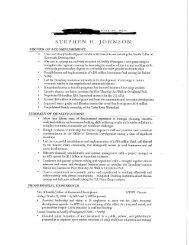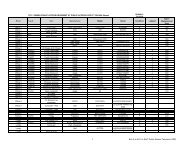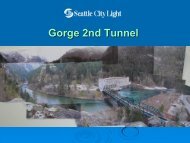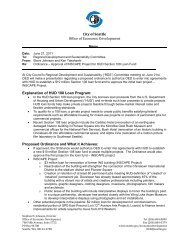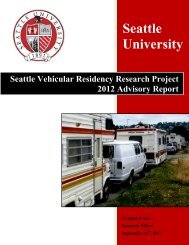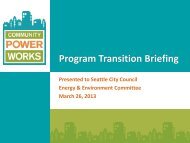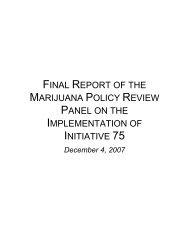2013 Water System Plan, Volume II - Seattle City Clerk's Office - City ...
2013 Water System Plan, Volume II - Seattle City Clerk's Office - City ...
2013 Water System Plan, Volume II - Seattle City Clerk's Office - City ...
Create successful ePaper yourself
Turn your PDF publications into a flip-book with our unique Google optimized e-Paper software.
A. Types of Valves<br />
The following are types of valves used in the SPU <strong>Water</strong> <strong>System</strong><br />
Valve<br />
Line<br />
Distribution<br />
District<br />
Check<br />
Gate<br />
Butterfly<br />
Pressure Relief and<br />
Pressure Regulating<br />
Air Relief,<br />
Air Vacuum, Air<br />
Release<br />
Air and Vacuum<br />
Air Release<br />
Use in SPU <strong>Water</strong> <strong>System</strong><br />
Line valves are typically either gate or butterfly valves, depending on pipeline size. Ball and plug<br />
valves may be used in the following situations: high pressure (±250 psi), significant throttling<br />
under high flow rates, control of pressure surges, or where throttling of high pressure<br />
differentials may be required.<br />
Gate valves are preferred where possible. They completely exit the flow path when fully open<br />
and allow drained water mains to fill without bypasses. Gate valves require space for a valve<br />
bonnet above or to the side (laydown valves) of the pipeline. Cover over water main may be<br />
critical. In cases where substandard cover is allowed, the gate valve operating nut must be<br />
below the bottom of the paving. This is particularly sensitive for concrete pavement, which<br />
tends to be thick. Gate valves are typically more expensive than butterfly valves. Laydown<br />
valves must be operable from the street surface and require a sealed right angle gearbox.<br />
(See Std <strong>Plan</strong> 030 for standard cover requirements.)<br />
Butterfly valves are frequently used on larger pipelines. All valves 16-inches and larger should<br />
be full-size inline butterfly valves and be installed in vaults. Valves under 16-inches can be<br />
either gate or butterfly valves. Standard practice is to use gate valves. Butterfly valves 16” or<br />
larger must be installed with a bypass to allow a drained pipe to fill without throttling the<br />
butterfly valve seats. Throttling of large-diameter butterfly valves with pressure differentials of<br />
over 50 psi is a primary reason seats have been destroyed after only one or two usages. Make<br />
provision for replacement of butterfly valves in the vault design. Include a dismantling joint, or<br />
similar, to enable disassembly of the pipe.<br />
Distribution line valves should be placed at interties and roadway intersections located at<br />
street margins. The valves should be spaced to provide operational flexibility and redundancy<br />
to the water system and reduce impacts of shut down blocks.<br />
District valves are typically gate valves and separate different pressure zones. They require the<br />
valve to be installed in a chamber with a special lock-out tag or cover on the operator to<br />
prevent accidental operation.<br />
Check valve is a special valve that only allows flow in one direction through the valve. Check<br />
valves are usually installed in vaults. Several styles are available. Check the valve’s coefficient<br />
value (C) and slam characteristics before finalizing check valve design.<br />
Control valves (pressure reducing, pressure sustaining, etc) typically are installed at the<br />
interface between pressure zones. They are sized based on anticipated fire flow at projected<br />
peak hour demand conditions. Control valve stations should be below-grade in a concrete<br />
vault, and include a mainline meter and a bypass to the main waterline.<br />
Air valves are most commonly found on transmission pipelines and large feeder mains. They<br />
are not common on small-diameter distribution mains. There are two general types of air<br />
valves: air and vacuum valves and air release valves.<br />
Air and vacuum valves are large-orifice valves used to allow large volumes of air to flow into<br />
or out of the pipe during filling and draining and to prevent a vacuum from valve operations,<br />
rapid draining, column separation, or other causes. Without air vacuum valves, a vacuum can<br />
cause the pipe to collapse from atmospheric pressure.<br />
Fire hydrants can be used to release air at the high points of the distribution system and<br />
between isolation valves while filling water mains.<br />
Air release valves are small orifice valves that may be required at pipe high points or at<br />
significant changes in pipe grade to release small amounts of slowly accumulating air buildup in<br />
the pipeline.<br />
Air is dissolved or entrained in water from many sources including naturally occurring surface<br />
waters, at open reservoirs and while filling the pipeline at locations of cascading flow in a<br />
partially filled pipe to name a few. Entrained air may be dissolved into the water as pipeline<br />
pressure increases (decreasing pipe slope). Entrained air may collect at the top of the pipe at<br />
abrupt downward changes of pipe grade. Dissolved air may come out of solution many miles<br />
from the air source as the pressure decreases, especially at high points. Air may bubble out of<br />
solution where there is significant increase of flow velocity caused by changing pipe diameters<br />
(Bernoulli principle) and increasing pipe slope, and changes in pipeline elevations and reduced<br />
pressure. Reducing the accumulation of air within a pipe decreases head loss in the pipeline.<br />
5-32 SPU Design Standards and Guidelines



